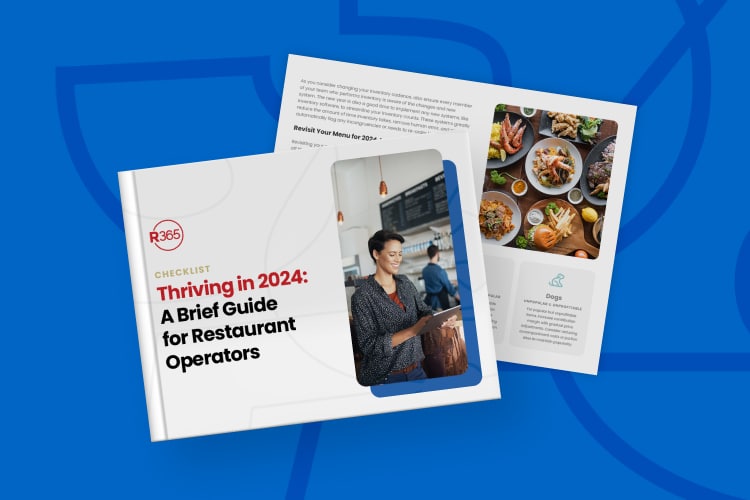Staffing your restaurant with a great team is critical to success. Your individual hiring decisions define your company culture over the long term, impacting both customer experience and employee retention. Short-term restaurant hiring challenges, like filling open roles because you’re understaffed, may seem like the most urgent day-to-day priority. However, for the overall health of your restaurant business, it pays to put energy and resources into your long-term hiring and retention strategy as well.
Overcoming restaurant hiring challenges requires thoughtful ideas and consistent effort. Many restaurants struggle with issues surrounding employee turnover that aren’t a quick fix, grappling with growth opportunities, providing work/life balance, or maintaining a healthy culture in a high-pressure workplace environment.
Your hiring plan and your retention plan may differ in approach, but they are closely dependent on each other. Despite the challenges, you need to hire and retain amazing restaurant employees, right now and in the future. How can you start developing a long-term hiring strategy?
Encourage restaurant employment as a career choice
While there are many areas to start with, your long-term strategy should first focus on the big picture for your employees. Entry-level employees and restaurant staff certainly do care about details like pay and company culture, but they also care deeply about what opportunities are available to them in the future.
Providing employees with opportunities to grow within the restaurant industry can help them understand that it can be a career. If you can invest in your employees as long-term team members, rather than just hourly staff, you can reap the rewards of a dedicated workforce.
For instance, offering new opportunities and training to employees can help set them up for success in future restaurant management roles. Essentially, you want to provide employees with the opportunity to become proficient in different operational areas, while also connecting the task with how it impacts the restaurant’s success.
In practice, this looks like assigning an employee a specific responsibility for something that affects the restaurant’s P&L. It doesn’t have to be a large, mission-critical task. Maybe an employee can be responsible for completing scheduling or inventory or placing a chemical order or cheese order. While you should obviously provide training for the task, the employee should also be allowed to make (and learn how to correct) some mistakes.
Once the employee is responsible for the task, you need to correlate the task with how it affects finances or operations. It’s critical to show the employee how they’re making a difference in the business, and why this is a valuable management skillset to learn.
Make sure to communicate that this isn’t just another job responsibility that you are attaching onto their roles. Rather, you are teaching them how to manage aspects of the business. If you can communicate to employees that this is a long-term investment in their industry knowledge, you may find that they are more likely to stick around for the long term.
Providing employees with the opportunities to become proficient in these operational areas has many benefits. First, you are preparing a pipeline for your next potential managers. Second, by investing in your employees’ expertise, you are signaling that you are invested in their success for the long-term. And finally, cross-training can help take work off your management team’s plates, while growing a positive culture of teamwork.
Offer a competitive wage and benefits
Of course, every hiring strategy needs to examine the financial component of staffing. Offering a competitive wage or salary, or desirable benefits like medical benefits and paid time off, can help increase retention rates.
To start, all your job postings should specifically list salary and wage information and any benefits or bonuses available. Knowing if your job role covers cost of living is a critical piece of the decision-making process for candidates.
If you are offering wages and benefits that stand out in the industry, make sure to make this information as clear as possible. The hospitality industry is in constant hiring mode. If you wait too long to hire a candidate, the person may accept another opportunity before you have the chance. To boost your hiring, communicate directly about your wages and benefits from the beginning, and promptly extend a job offer when you are interested in a hire.
For your salaried management roles, consider examining a common issue in the restaurant industry that can lead to high turnover.
Historically, many restaurants have used salaried managers as a type of support staff. In practice, managers may be completing not just managerial tasks like ordering and inventory, but also the small tasks that never end in a restaurant, like clearing tables and washing dishes. For many managers, this can add up to working 50-80 hours a week.
However, working that many hours a week at certain salaries may end up putting managers at a lower hourly rate than servers, line cooks, or other staff. In today’s hiring landscape, if your managers are making less than the rest of your team on an hourly basis, you may experience high turnover for that role. If this is the case in your restaurant, you may want to examine how your salaried wages compare in a competitive labor market.
Additionally, the bigger issue now is that due to the current labor shortage, many restaurants are specifically hiring managers as service or support managers to fill the staffing gap. The turnover is extremely high because these managers are not paid well, nor are they being developed as managers. While this might seem like a good way to hire much needed help in the short term and keep your restaurant open, it doesn’t bode well for the long term.
Promote your restaurant business, your culture, and your benefits
A key piece of an effective employee retention strategy is to build and maintain a positive reputation as a good place to work. Creating a reputation like this requires work, and it doesn’t happen overnight. You need to consistently promote your workplace, your unique culture, and the benefits that you offer to employees. In this environment, your restaurant needs to impress a job candidate just as much as the candidate needs to impress you.
Fundamentally, you need to have a culture for your restaurant before you can “promote” it. Your restaurant should represent something definitive. For example, your restaurant may prioritize being active in the community, sourcing local ingredients, or preparing specialty dishes from scratch. When employees feel that they are doing something important in the industry by being part of your restaurant, it can lead to much stronger team retention.
In addition, make sure to consider how your culture encourages growth and mentorship. Many cooks seek training and development, because working in kitchens with strong mentorship can function as a kind of culinary school. As mentioned above, when your employees have opportunities for growth through new skills, they are more likely to stick around.
To effectively communicate about your company to new hires, promote your values everywhere you can. Examine your job descriptions, your careers page, the interview process, and anywhere else you interact with potential applicants.
Finally, don’t forget to focus on your existing staff members. Company leadership and store-level managers are responsible for cultivating an environment that is positive, healthy, and supportive for restaurant employees. Your retention strategy should focus as much time and energy on retaining your existing team members as on recruiting new employees.
Hire with your retention strategy in mind
Your hiring strategy should be focused on how to hire and retain the best restaurant employees possible, now and in the long term. Employee retention should be a focus, even during your initial recruitment and hiring phases.
Start by prioritizing culture fit and motivation over just industry experience. Sometimes, it may feel like you just need to fill open roles ASAP, no matter who it is. However, staff members who are only looking for a job may seem like a necessary hire now, but these short-term hires can waste training efforts and leave your company with a high turnover rate.
Hires that aren’t a good fit for your company culture can be a detriment over the long term. When you are interviewing candidates, take the time to look for applicants who are looking for a career, rather than just a job.
With this approach, you may need to prioritize engagement and a drive to learn over direct industry experience. Just because a candidate already has the skills doesn’t mean the person will be the best fit for your culture. Someone who is motivated to learn may end up being a better fit for your company over the long term, even if additional restaurant training is required in the short term.
A career path structure can be a powerful tool for long-term hiring and retention. It is an investment to build up an employee from a server to a manager. However, this kind of investment is powerful, because professional training is not very common in the restaurant industry.
When you can train a staff member at every step, the employee knows your organization inside and out. It can also help inspire other team members to see the connection between an entry-level role and career opportunities.
Encouraging employee loyalty is not a quick fix; it is a comprehensive strategy. Details like mentorship, industry skills training, and a culture that represents something definitive are difficult to implement, but worth reaching for over the long term.
Begin development in the early stages as part of your retention strategy
Once employees are onboard, focusing on investing in them for the long run must be part of your retention strategy. Create opportunities for growth, and then develop employees to build their value to your restaurant group. Employees who don’t feel that there is room for growth and learning will increase your turnover rate. When you develop your employees, you increase their capacity to accomplish more.
Training and development are crucial to your retention strategy, as well as to a positive customer experience. Ongoing development is how you cultivate loyal, committed employees. But early employee development must extend beyond entry-level. Your development initiatives must begin at the store manager level. An unprepared manager who doesn’t stick around impacts not only your turnover costs, but impacts employee morale, resulting in greater staff turnover. Additionally, if you promote a poorly trained replacement manager, you’ll be in a never-ending cycle of manager and employee turnover.
According to the National Restaurant Association, 90% of restaurant managers start at the entry level. So, you should think of all new hires and existing employees as potential managers, then develop and train them accordingly.
Build relationships with community organizations to bolster diversity and inclusion
Your team is made up of many individuals who all bring different experiences and skillsets to the table. A diverse and inclusive workplace is critical to every business, and it is more important than ever to focus on diversity in your hiring practices and retention strategy. It’s important to recognize the value of people that are different in personality and who have different skillsets. One of the biggest weaknesses in restaurant retention is the belief that building a company culture means that everyone is the same. Think about different personalities, ethnic backgrounds and skillsets that can enhance your team.
First, focus on writing inclusive job descriptions and expanding your marketing to diverse demographics. Re-examining your recruitment materials and where you promote open positions can help you expand your audience.
In addition, building relationships with local community organizations can help fuel this work. Some community organizations specifically work with groups typically underserved with job opportunities. You may be able to reach outside typical job boards, finding candidates who are highly motivated. With a new approach, you can help grow the hiring pool and strengthen your team.
Conclusion
The restaurant industry can provide an exciting, fulfilling career. Focusing on your long-term hiring strategy can help you communicate this to applicants and staff a great team. Your restaurant can overcome restaurant hiring challenges with a strategic approach that looks to the long-term health of your culture and company.
Are you looking for a restaurant hiring solution that can help support your long-term staffing goals? R365 HIRE makes it easy to attract, hire, and onboard the best employees for your restaurant group.



